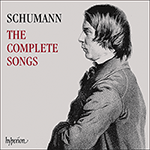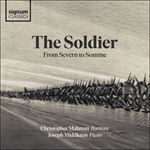
Welcome to Hyperion Records, a British classical label devoted to presenting high-quality recordings of music of all styles and from all periods from the twelfth century to the twenty-first.
Hyperion offers both CDs, and downloads in a number of formats. The site is also available in several languages.
Please use the dropdown buttons to set your preferred options, or use the checkbox to accept the defaults.

July 1840 was especially rich in songs. It is the month, above all, of Schumann’s settings of Adelbert von Chamisso. The famous Frauenliebe und -leben cycle was composed in this July, as well as six further songs which are not to be found in the first edition of that poet’s work (1831). The fourth edition of these best-selling poems dates from 1837 and it seems likely that this is the collection from which Schumann worked. As in the first edition, the Frauenliebe und -leben stands proudly at the head of Chamisso’s volume. But the poet enriches the later edition with evidence of his internationalist sympathies: an Icelandic saga, and an Idylle originally in the Tonga tongue (Chamisso had travelled in the South Seas and became a authority on the Polynesian languages) bring the collection to an close.
Less exotic perhaps, but of more interest to Schumann, were two further sets of translations in the 1837 edition of Chamisso – one of four French poems by Pierre-Jean de Béranger (1780-1857), the other of four Danish poems by Hans Christian Andersen. In July 1840 Schumann set two of the first group of poems: Die Kartenlegerin (Hyperion Schumann Edition Volume 3) and Die rote Hanne. (One of the other Béranger items is The prophecy of Nostradamus concerning the year 2000 – as unsuitable for music as its predictions are inaccurate.)
In Geibel’s Gedichte the Andersen poems are printed immediately after the Béranger; they appear grouped under a subtitle – Nach dem Dänischen von Andersen (‘From the Danish of Andersen’). These are the poems which Schumann set as the first four songs of his Op 40. They are numbered 1 to 4 and the composer paid Chamisso the compliment of setting them all to music; moreover he adopted the translator’s order as if the German poet had created a work of art in its own right by arranging the four poems as an expressive sequence. But Schumann was not satisfied to finish the group with the madness of Der Spielmann. Love must win the day, and he searched through the Chamisso volume until he found something sufficiently upbeat. The fifth poem of Op 40, Verratene Liebe, is subtitled Neugriechisch – ‘modern Greek’– so this too is a translation. In fact Chamisso had taken it from a French source by Charles-Claude Fauriel.
The enormously prolific Hans Christian Andersen (1805-1875) was born in Copenhagen. He remains world-famous for his fairytales but he was author of almost every other genre – the German translation of the Werke appeared in 1847 and runs to fifty volumes – plays, novels, poems. travel books and autobiographies. He was born in poverty and gradually fought his way to recognition, drawing on the pain and rejections of his childhood for much of his work including the fairytales. When Schumann set these poems Andersen was only thirty-five years old and not yet the legend he was to become. How much the composer knew of the rest of the poet’s work in 1840 is not known, but Schumann was sufficiently in touch with the world of contemporary literature to know that Andersen was considered an up-and coming author.
The first personal connection between Andersen and Schumann occurred between the composition of the songs and their first appearance in print. In June 1841 the two narrowly missed each other in Leipzig when Andersen passed through that city. On this occasion the poet met Mendelssohn. During a concert visit to Copenhagen (March/April 1842) Clara met Andersen and it seems that Schumann was very pleased by the prospect of her meeting the poet. He had already formed an opinion of Andersen as an author: ‘Very wise, so clever, so child-like’ he wrote to Clara. She herself had decided that he was ‘frightfully vain and egotistic’ as well as ‘very ugly’, but she brought back a friendly letter for her husband from Andersen. The composer sketched a reply to Andersen telling him that he had read the novel Kun en Spillemand – ‘Only a Fiddler’. Since setting the four poems in Chamisso’s translations it seems that this extraordinary novel about Christian, an aspiring musician whose ambitions come to nought within an almost fairytale scenario influenced by Andersen’s own painful reminiscences, had been Schumann’s first experience of the Dane’s work.
The reason this reply was not sent was probably because the composer was waiting for the Op 40 songs to arrive from the printer. On 1 October 1842 he sent Andersen a copy of the songs (published by Kistner of Leipzig, and simultaneously in Denmark – because of the Danish connection of course – by the firm Lose & Olsen) which were dedicated to the poet. ‘Perhaps the settings will seem strange to you’ Schumann wrote, ‘ So at first did your poems to me. But as I grew to understand them better, my music took on a more unusual style’. Andersen replied in November mentioning that the composer Niels Gade had played through the music for him. At the same time he wrote to the Schumanns about his new novel Ahasverus inspired by the second part of Goethe’s Faust, no less. The highly-strung and self-absorbed Andersen was never shy about boasting about current successes and talking at length about future plans.
The composer and poet met for the first time in Leipzig on 22 June 1844. On this occasion Livia Frege (1818-1891), a soprano much admired by Schumann and Mendelssohn, was also invited. The Op 40 songs were performed, and according to Clara (who was surely the pianist) the poet received them ‘with seeming indifference’. In Andersen’s own mémoires he remembered the evening as being ‘poetic’ with only the composer and himself as audience. Clara’s charming presence, and that of Livia Frege, are not mentioned. (It was rumoured that Andersen had been unhappily in love with Jenny Lind, another friend of the Schumanns, but the poet was also certainly tormented by his homosexuality). In any case, lieder were small beer and he was openly ambitious. Andersen was more interested in interesting Schumann in a much larger project, and proposed his fairytale Die Glücksblume or Die Blume des Glücks, ‘The Flower of Happiness’, as the basis of an opera. Schumann was taken with the idea and the two men corresponded about it. The idea came to nothing, almost certainly because of the mental crisis which overtook the composer in the autumn of 1844. Schumann was aware of the difficulties of Andersen’s personality: a conversation with the Danish composer Gade in 1846 led him to write in his Tagebuch of the poet’s ‘childish vanity’ (it may have taken him some time to come to agree with Clara’s instant reaction) as well as Andersen’s inability, also like a child, to avoid the open expression of opinions that most people would suppress with good manners. In comparison with Dickens the Schumanns escaped lightly. The English novelist admired Andersen’s work and invited him to stay for a fortnight at Gad’s Hill Place in the summer of 1857. The Dane, a combination of Pecksniff and the Ugly Duckling, as Dickens later remarked, stayed five weeks and was counted by the Dickens children the most unbearable guest the family had ever entertained.
from notes by Graham Johnson © 2002
extrait des notes rédigées par Graham Johnson © 2010
Français: Marie-Stella Pâris
aus dem Begleittext von Graham Johnson © 2010
Deutsch: Henning Weber
 Schumann: The Complete Songs Schumann: The Complete SongsSchumann’s songs are among the greatest musical achievements of the nineteeth century, and this marvellous collection comprises Schumann’s complete songs, presented for the first time in their chronological sequence of composition, with complete s ...» More |
 The Soldier The SoldierThreaded throughout this remarkable recital is the poetry of Housman’s 'A Shropshire Lad' and its themes of life, loss and the transience of youth. In a programme originally devised for the centenary of the outbreak of World War I, this evolved in ...» More |

